Tribhuvanesh Orekondy
Reinforcement Learning of Adaptive Acquisition Policies for Inverse Problems
Jul 10, 2024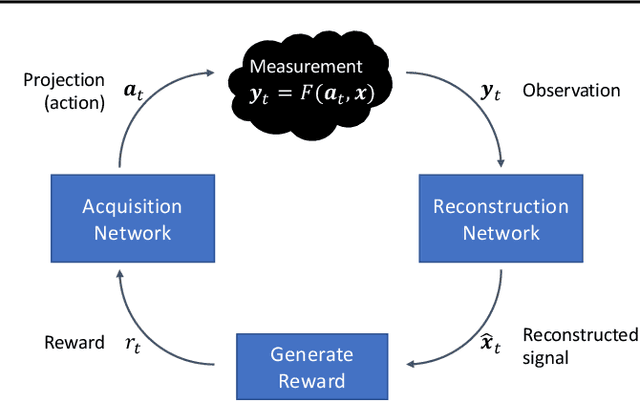

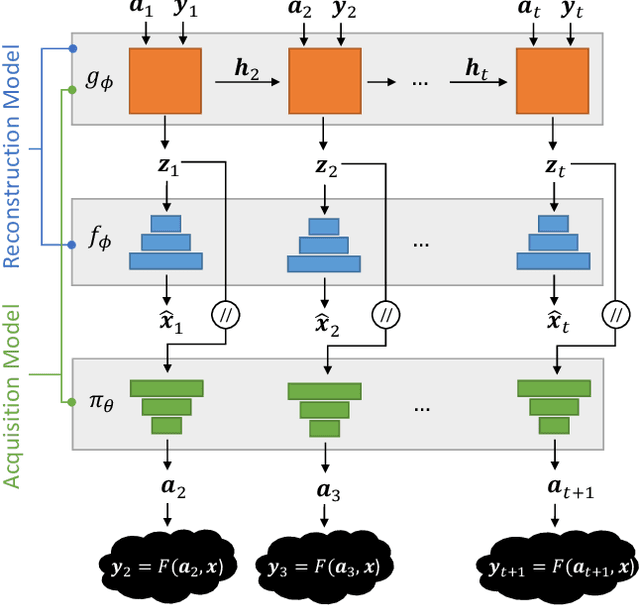

Abstract:A promising way to mitigate the expensive process of obtaining a high-dimensional signal is to acquire a limited number of low-dimensional measurements and solve an under-determined inverse problem by utilizing the structural prior about the signal. In this paper, we focus on adaptive acquisition schemes to save further the number of measurements. To this end, we propose a reinforcement learning-based approach that sequentially collects measurements to better recover the underlying signal by acquiring fewer measurements. Our approach applies to general inverse problems with continuous action spaces and jointly learns the recovery algorithm. Using insights obtained from theoretical analysis, we also provide a probabilistic design for our methods using variational formulation. We evaluate our approach on multiple datasets and with two measurement spaces (Gaussian, Radon). Our results confirm the benefits of adaptive strategies in low-acquisition horizon settings.
Probabilistic and Differentiable Wireless Simulation with Geometric Transformers
Jun 21, 2024Abstract:Modelling the propagation of electromagnetic signals is critical for designing modern communication systems. While there are precise simulators based on ray tracing, they do not lend themselves to solving inverse problems or the integration in an automated design loop. We propose to address these challenges through differentiable neural surrogates that exploit the geometric aspects of the problem. We first introduce the Wireless Geometric Algebra Transformer (Wi-GATr), a generic backbone architecture for simulating wireless propagation in a 3D environment. It uses versatile representations based on geometric algebra and is equivariant with respect to E(3), the symmetry group of the underlying physics. Second, we study two algorithmic approaches to signal prediction and inverse problems based on differentiable predictive modelling and diffusion models. We show how these let us predict received power, localize receivers, and reconstruct the 3D environment from the received signal. Finally, we introduce two large, geometry-focused datasets of wireless signal propagation in indoor scenes. In experiments, we show that our geometry-forward approach achieves higher-fidelity predictions with less data than various baselines.
Simulating, Fast and Slow: Learning Policies for Black-Box Optimization
Jun 06, 2024
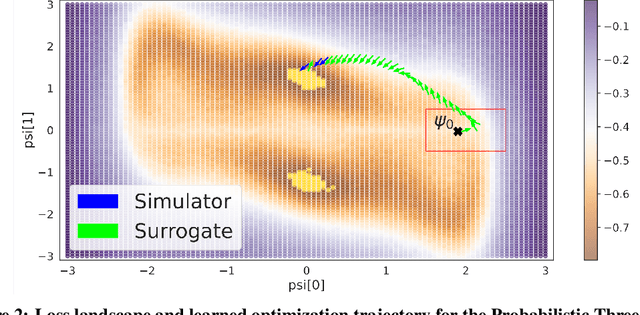
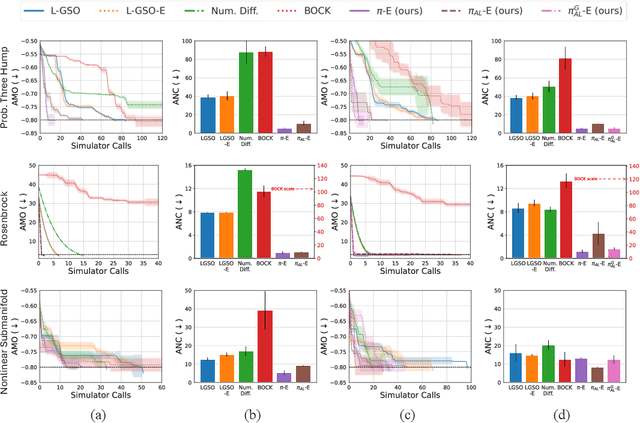
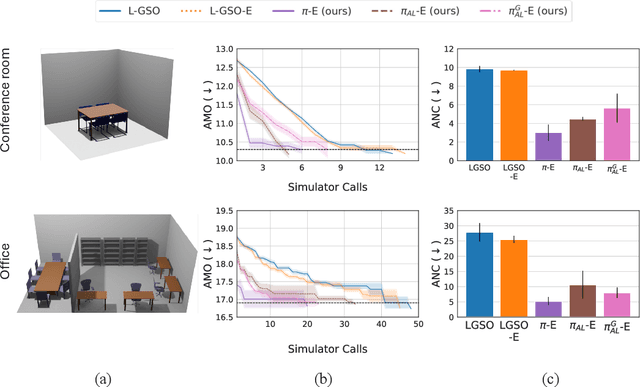
Abstract:In recent years, solving optimization problems involving black-box simulators has become a point of focus for the machine learning community due to their ubiquity in science and engineering. The simulators describe a forward process $f_{\mathrm{sim}}: (\psi, x) \rightarrow y$ from simulation parameters $\psi$ and input data $x$ to observations $y$, and the goal of the optimization problem is to find parameters $\psi$ that minimize a desired loss function. Sophisticated optimization algorithms typically require gradient information regarding the forward process, $f_{\mathrm{sim}}$, with respect to the parameters $\psi$. However, obtaining gradients from black-box simulators can often be prohibitively expensive or, in some cases, impossible. Furthermore, in many applications, practitioners aim to solve a set of related problems. Thus, starting the optimization ``ab initio", i.e. from scratch, each time might be inefficient if the forward model is expensive to evaluate. To address those challenges, this paper introduces a novel method for solving classes of similar black-box optimization problems by learning an active learning policy that guides a differentiable surrogate's training and uses the surrogate's gradients to optimize the simulation parameters with gradient descent. After training the policy, downstream optimization of problems involving black-box simulators requires up to $\sim$90\% fewer expensive simulator calls compared to baselines such as local surrogate-based approaches, numerical optimization, and Bayesian methods.
Transformer-Based Neural Surrogate for Link-Level Path Loss Prediction from Variable-Sized Maps
Oct 10, 2023Abstract:Estimating path loss for a transmitter-receiver location is key to many use-cases including network planning and handover. Machine learning has become a popular tool to predict wireless channel properties based on map data. In this work, we present a transformer-based neural network architecture that enables predicting link-level properties from maps of various dimensions and from sparse measurements. The map contains information about buildings and foliage. The transformer model attends to the regions that are relevant for path loss prediction and, therefore, scales efficiently to maps of different size. Further, our approach works with continuous transmitter and receiver coordinates without relying on discretization. In experiments, we show that the proposed model is able to efficiently learn dominant path losses from sparse training data and generalizes well when tested on novel maps.
MIMO-GAN: Generative MIMO Channel Modeling
Mar 16, 2022

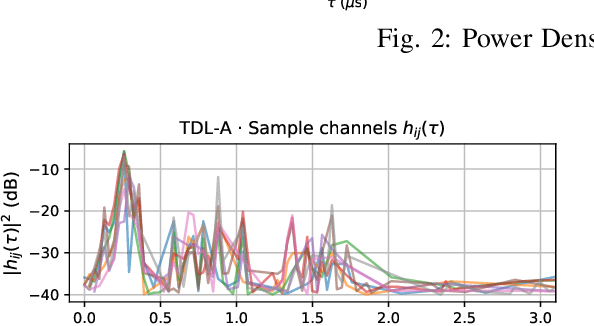
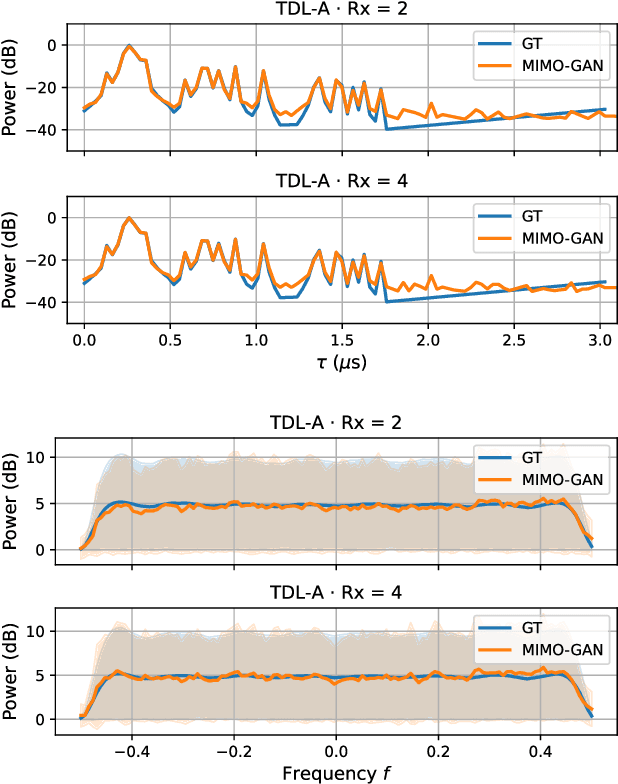
Abstract:We propose generative channel modeling to learn statistical channel models from channel input-output measurements. Generative channel models can learn more complicated distributions and represent the field data more faithfully. They are tractable and easy to sample from, which can potentially speed up the simulation rounds. To achieve this, we leverage advances in GAN, which helps us learn an implicit distribution over stochastic MIMO channels from observed measurements. In particular, our approach MIMO-GAN implicitly models the wireless channel as a distribution of time-domain band-limited impulse responses. We evaluate MIMO-GAN on 3GPP TDL MIMO channels and observe high-consistency in capturing power, delay and spatial correlation statistics of the underlying channel. In particular, we observe MIMO-GAN achieve errors of under 3.57 ns average delay and -18.7 dB power.
Sampling Attacks: Amplification of Membership Inference Attacks by Repeated Queries
Sep 01, 2020

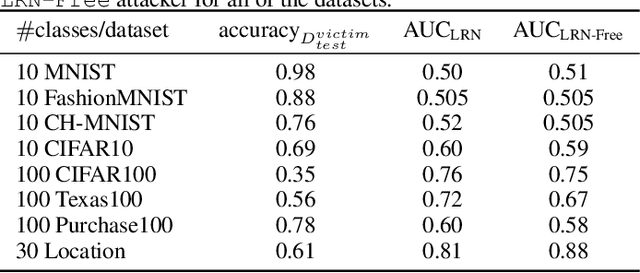
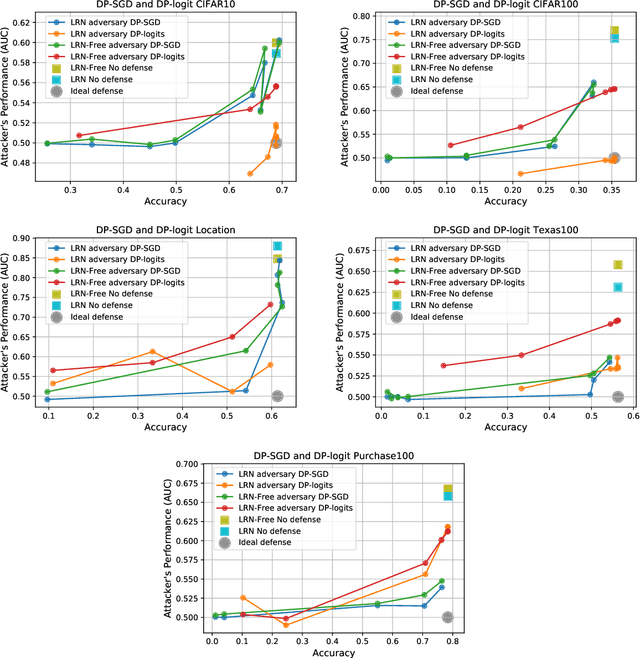
Abstract:Machine learning models have been shown to leak information violating the privacy of their training set. We focus on membership inference attacks on machine learning models which aim to determine whether a data point was used to train the victim model. Our work consists of two sides: We introduce sampling attack, a novel membership inference technique that unlike other standard membership adversaries is able to work under severe restriction of no access to scores of the victim model. We show that a victim model that only publishes the labels is still susceptible to sampling attacks and the adversary can recover up to 100% of its performance compared to when posterior vectors are provided. The other sides of our work includes experimental results on two recent membership inference attack models and the defenses against them. For defense, we choose differential privacy in the form of gradient perturbation during the training of the victim model as well as output perturbation at prediction time. We carry out our experiments on a wide range of datasets which allows us to better analyze the interaction between adversaries, defense mechanism and datasets. We find out that our proposed fast and easy-to-implement output perturbation technique offers good privacy protection for membership inference attacks at little impact on utility.
GS-WGAN: A Gradient-Sanitized Approach for Learning Differentially Private Generators
Jun 15, 2020
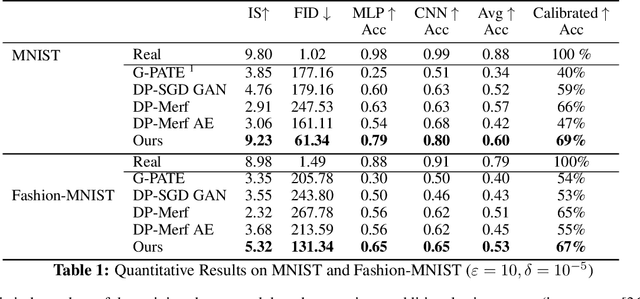

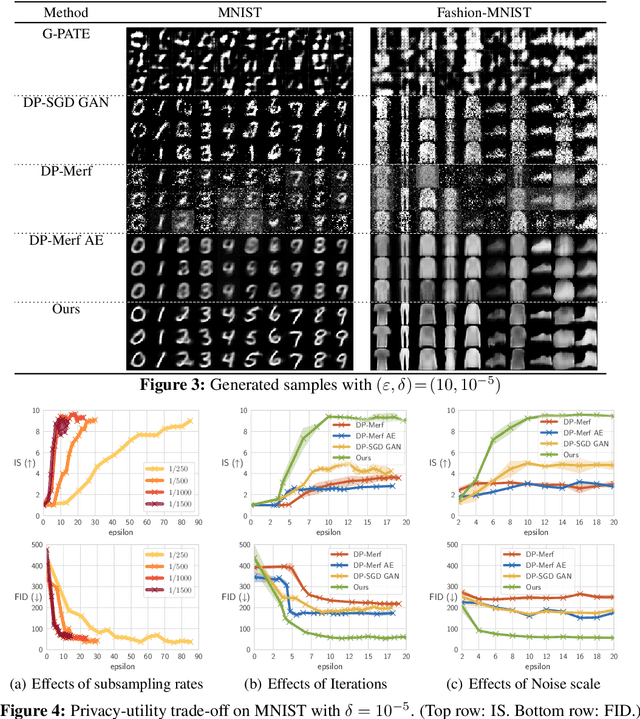
Abstract:The wide-spread availability of rich data has fueled the growth of machine learning applications in numerous domains. However, growth in domains with highly-sensitive data (e.g., medical) is largely hindered as the private nature of data prohibits it from being shared. To this end, we propose Gradient-sanitized Wasserstein Generative Adversarial Networks (GS-WGAN), which allows releasing a sanitized form of the sensitive data with rigorous privacy guarantees. In contrast to prior work, our approach is able to distort gradient information more precisely, and thereby enabling training deeper models which generate more informative samples. Moreover, our formulation naturally allows for training GANs in both centralized and federated (i.e., decentralized) data scenarios. Through extensive experiments, we find our approach consistently outperforms state-of-the-art approaches across multiple metrics (e.g., sample quality) and datasets.
InfoScrub: Towards Attribute Privacy by Targeted Obfuscation
May 20, 2020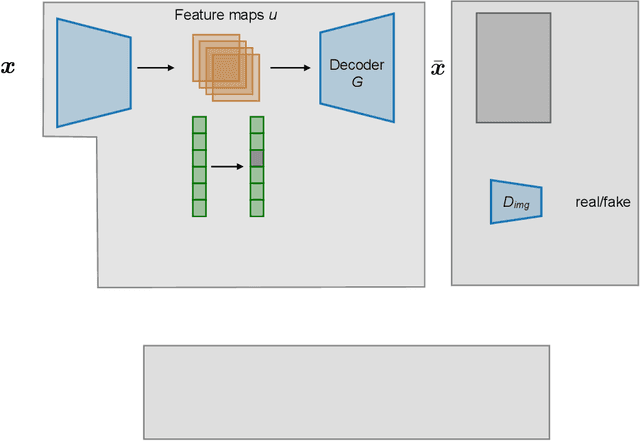



Abstract:Personal photos of individuals when shared online, apart from exhibiting a myriad of memorable details, also reveals a wide range of private information and potentially entails privacy risks (e.g., online harassment, tracking). To mitigate such risks, it is crucial to study techniques that allow individuals to limit the private information leaked in visual data. We tackle this problem in a novel image obfuscation framework: to maximize entropy on inferences over targeted privacy attributes, while retaining image fidelity. We approach the problem based on an encoder-decoder style architecture, with two key novelties: (a) introducing a discriminator to perform bi-directional translation simultaneously from multiple unpaired domains; (b) predicting an image interpolation which maximizes uncertainty over a target set of attributes. We find our approach generates obfuscated images faithful to the original input images, and additionally increase uncertainty by 6.2$\times$ (or up to 0.85 bits) over the non-obfuscated counterparts.
Prediction Poisoning: Utility-Constrained Defenses Against Model Stealing Attacks
Jun 26, 2019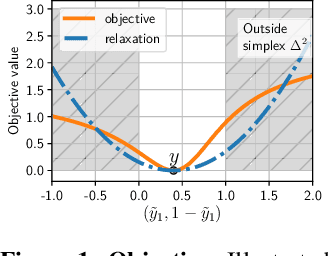
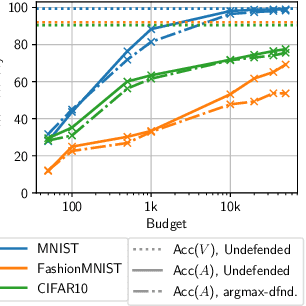
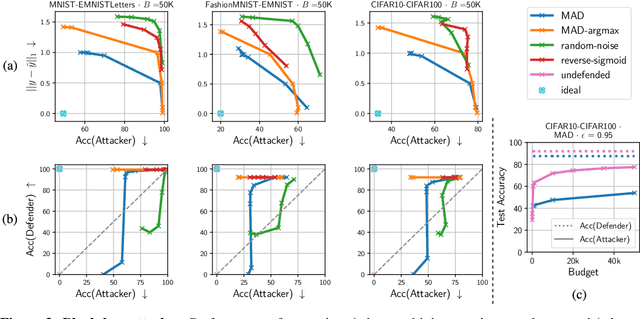

Abstract:With the advances of ML models in recent years, we are seeing an increasing number of real-world commercial applications and services e.g., autonomous vehicles, medical equipment, web APIs emerge. Recent advances in model functionality stealing attacks via black-box access (i.e., inputs in, predictions out) threaten the business model of such ML applications, which require a lot of time, money, and effort to develop. In this paper, we address the issue by studying defenses for model stealing attacks, largely motivated by a lack of effective defenses in literature. We work towards the first defense which introduces targeted perturbations to the model predictions under a utility constraint. Our approach introduces the perturbations targeted towards manipulating the training procedure of the attacker. We evaluate our approach on multiple datasets and attack scenarios across a range of utility constrains. Our results show that it is indeed possible to trade-off utility (e.g., deviation from original prediction, test accuracy) to significantly reduce effectiveness of model stealing attacks.
Knockoff Nets: Stealing Functionality of Black-Box Models
Dec 06, 2018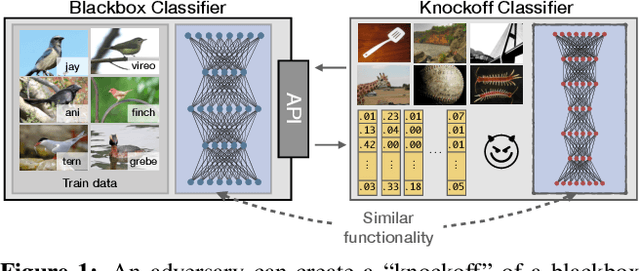

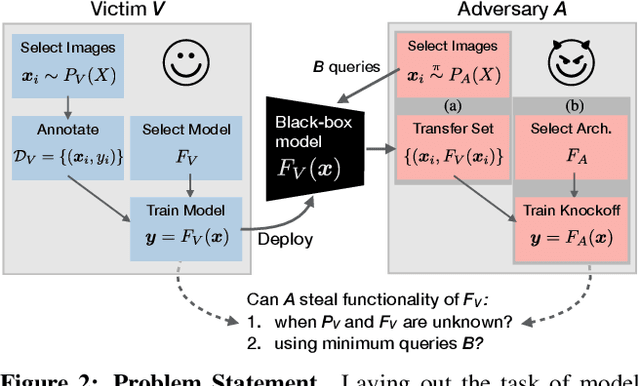

Abstract:Machine Learning (ML) models are increasingly deployed in the wild to perform a wide range of tasks. In this work, we ask to what extent can an adversary steal functionality of such "victim" models based solely on blackbox interactions: image in, predictions out. In contrast to prior work, we present an adversary lacking knowledge of train/test data used by the model, its internals, and semantics over model outputs. We formulate model functionality stealing as a two-step approach: (i) querying a set of input images to the blackbox model to obtain predictions; and (ii) training a "knockoff" with queried image-prediction pairs. We make multiple remarkable observations: (a) querying random images from a different distribution than that of the blackbox training data results in a well-performing knockoff; (b) this is possible even when the knockoff is represented using a different architecture; and (c) our reinforcement learning approach additionally improves query sample efficiency in certain settings and provides performance gains. We validate model functionality stealing on a range of datasets and tasks, as well as on a popular image analysis API where we create a reasonable knockoff for as little as $30.
 Add to Chrome
Add to Chrome Add to Firefox
Add to Firefox Add to Edge
Add to Edge